I became fascinated by dragonflies by accident. I was swimming in a lake in Canada and the price due for the glory of floating weightless under an open sky was navigating the reeds along the water’s edge afterward. There is something singularly unpleasant about the unseen, slimy tangles of water plants as they tickle and grab at your legs, so I was likely creating a small wake as I hurried to the salvation of my friend’s small boat. But as I churned past the last stand of stems, a large, unusual bug caught my eye. It was more than an inch long with huge round eyes, its body almost translucent. My friend explained that it was a dragonfly exuvia, the discarded exoskeleton of this flying insect’s larval life. I looked more closely and noticed the detailed mold of the creature’s tiny feet where it had clung to its final perch as an aquatic being. I carefully unhooked it from the stalk and saw a small opening on the back of its thorax, where the adult had climbed out to unfurl its wings and eventually fly away.
I learned later that darners (large dragonflies that are some of the most noticeable) usually go through this metamorphosis at night, limiting the chances of predation as their vulnerable bodies harden before they can fly. Some of these creatures spend up to five years in the water before a brief summer fling as aviators, while other adults migrate across continents to the breeding ponds of their ancestors (one study found green darners can fly up to 900 miles from Canada to the Gulf of Mexico, likely using sensory cues similar to those employed by migrating birds).
I carried my rescued exuvia back home across the border and perched it on my nature altar as a reminder of that fine swim and a symbol of my new appreciation of odonates (the Odonata order comprises dragonflies and damselflies).
Last month, on the second day of fall, I headed out on a sunny afternoon with my friend Harsi Parker, our local bug maven. (Her fabulous photos are featured in this post. Thanks, Harsi!) Our walks would more appropriately be called “stand and stares” because we can’t advance 10 feet without something in nature diverting our attention. After chasing the sound of a Hutton’s Vireo that—as birds are wont to do—went silent the minute we tried to pursue it, we headed to the birdwatching platform overlooking Meadowlake Pond. Our loose intention was to look for mushrooms, but it doesn’t feel right to start a walk from the 188th entrance to Island Center Forest without first checking the pond for water birds.
The unofficial gatekeepers of Island Center Forest, Common Ravens, were out in force, kraahing and klonking, and one—to our ears—even imitating a fax machine. Not a single duck plied the waters of the far shore, but soon something nearby piqued our interest. Several darner dragonflies had been cruising around, pausing briefly to take us into consideration before moving on, but then I noticed an interesting damselfly. It was nearly the exact shade of brown as the willow stalk it perched upon, but its body was longer than the damselflies I was familiar with, and it held its wings out when most damsels’ wings are held flush with their bodies. Harsi, who has a good camera and a good eye, zoomed in and confirmed it was a spreadwing damselfly, from a group which as their name implies, hold their wings outstretched from their bodies at about a 45-degree angle. As she photographed it, we noticed another, and soon it joined with the first one to mate, their conjoined bodies creating a comically accurate heart shape as they cruised around the willow. Tiny lover sky writers, they inscribed the air above the pond with their amour.
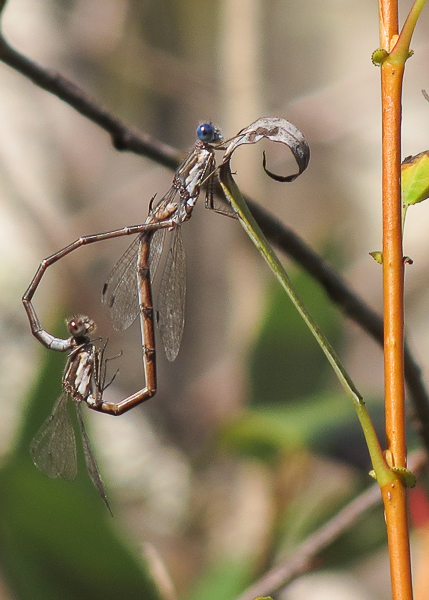
As Harsi checked her photos, she noticed a peculiar thorn-like protuberance on one female’s abdomen. She later learned that this was the spreadwing’s ovipositor (egg positioner). After mating (the heart-shaped fun) the male spreadwing holds the female by the thorax and guides her to what he determines to be the most promising spot, and continues to clasp her as she cuts into the plant with her sharp ovipositor and inserts the hope of their progeny. (If this paragraph sounds like a scene from The Handmaid’s Tale, nature is stranger than fiction I have noticed.)
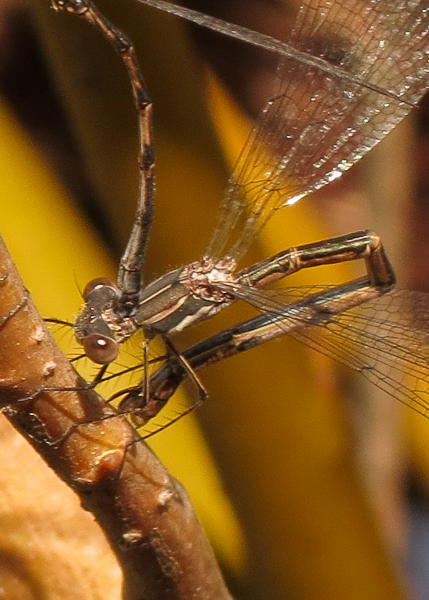
Looking back at the willow, now there were two couples engaged in what I laughingly dubbed an “odonate orgy”—a genetic face-off of sorts. The males’ bulging neon blue eyes not an inch apart seemed locked in a quiet battle of the fittest—“Our eggs will hatch first—and hatch better than yours!”
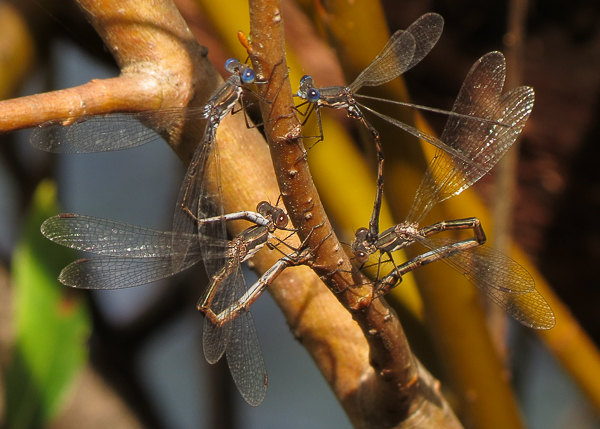
The spreadwings were not the only randy odonates about that day. Also circulating around the “willows of fertility” were two red dragonflies. Their color and habits made us guess they were members of the meadowhawk family—these insects are also known as darters, which aptly describes their movements. After much zig-zagging up, down and around us, the pair finally settled long enough for Harsi to snap a clear photo.
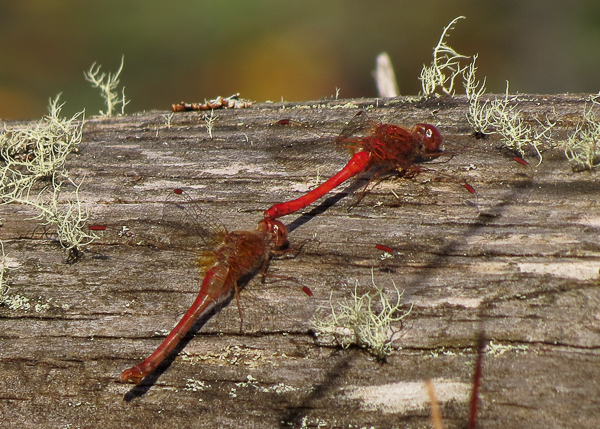
We spent nearly an hour standing at the pond, wondering over these aerial delights. Delineating different species of odonates can come down to features not readily noticeable unless you have them in hand. Luckily, Harsi’s photos contained enough identifying characteristics to make good educated guesses. After poring over guidebooks and online sources, she determined the damselflies to be Spotted Spreadwings (Lestes congener) and the others Autumn Meadowhawks (Sympetrum vicinum). Since then, both IDs have been confirmed by odonate experts—firsts confirmed sightings for both of us!
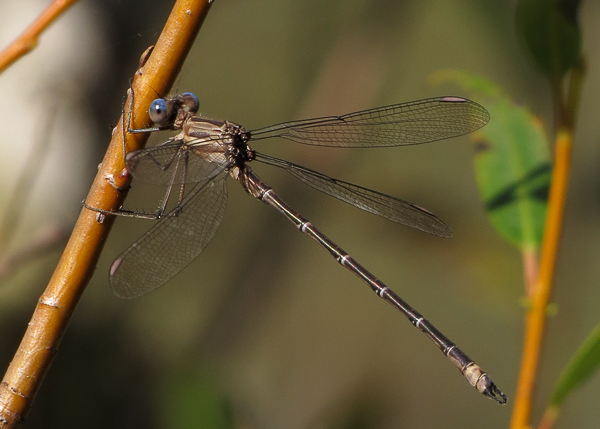
We later mused that perhaps the odonates foresaw the wet stretch of weather ahead and were making hay as the sun shone as it were. We considered the probable impressive numbers of damsels and dragons making heart shapes at ponds all over the island—their valentine-shaped farewell to summer and a love note to the next generation.

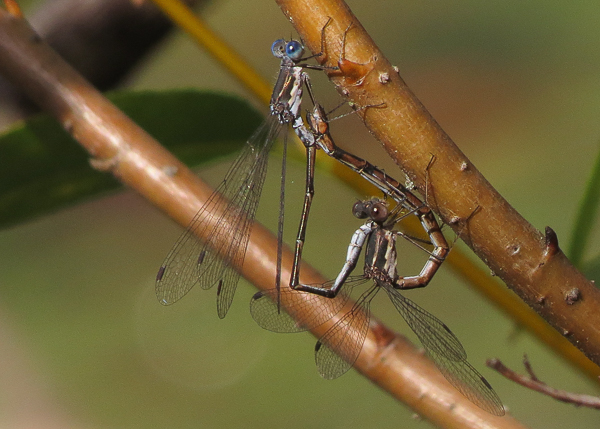
Really fun article, Catherine. And wonderful photos Harsi. That’s my favorite place to take my coffee and enjoy the pond. You’ve given me something else to look for.
So glad you liked it, Jane! That is a magical spot. Hope you see some odonates there the next sunny time you visit.
Wonderful! Thank you both!
Thanks for your note, Angela!
What glorious colors! The damselflies look like gold and enamel exquisite jewelry. At first I was jealous of the males’ beautiful blue eyes, but then I looked at the closeup of the female and thought her subtle soft greens and cream and gold were even lovelier. Thank you Kathryn and Harsi for sharing your lovely experience at the pond.
Yes! Thanks for writing, Rayna. Exquisite is a good word!
OH my this is a wonderful piece Kathryn! I love your writing and I learned so much about dragonflies through your story.
xoxo Jen
Thanks so much, Jen! They are amazing critters.
Kathryn I am so envious of your observation skills! This reminds me of the one time I could sit still long enough to see much. I was in the middle of chemo and rayna invited me to go bird watching at Christensen pond. I wasn’t having luck with birds so I trained my binoculars on the reeds breaking through the surface and was rewarded with tens of damsel flies climbing out of the pond, splitting out and drying their new wings. Wonderful article and photos.